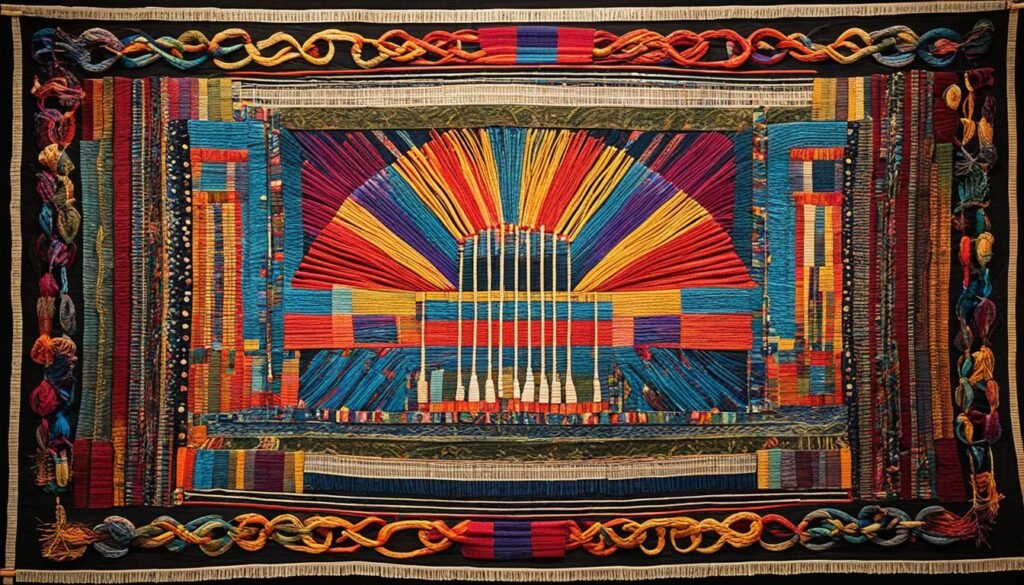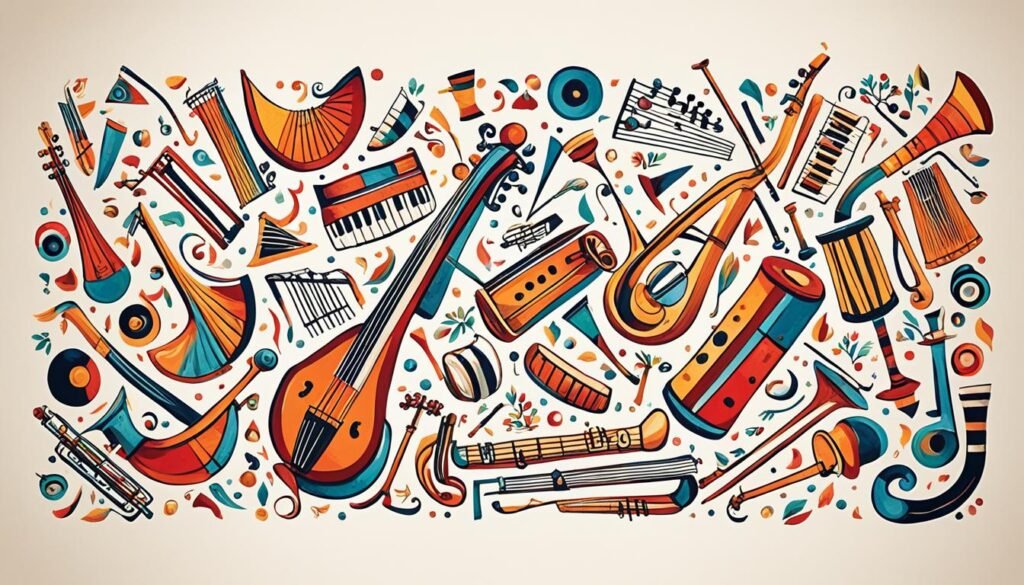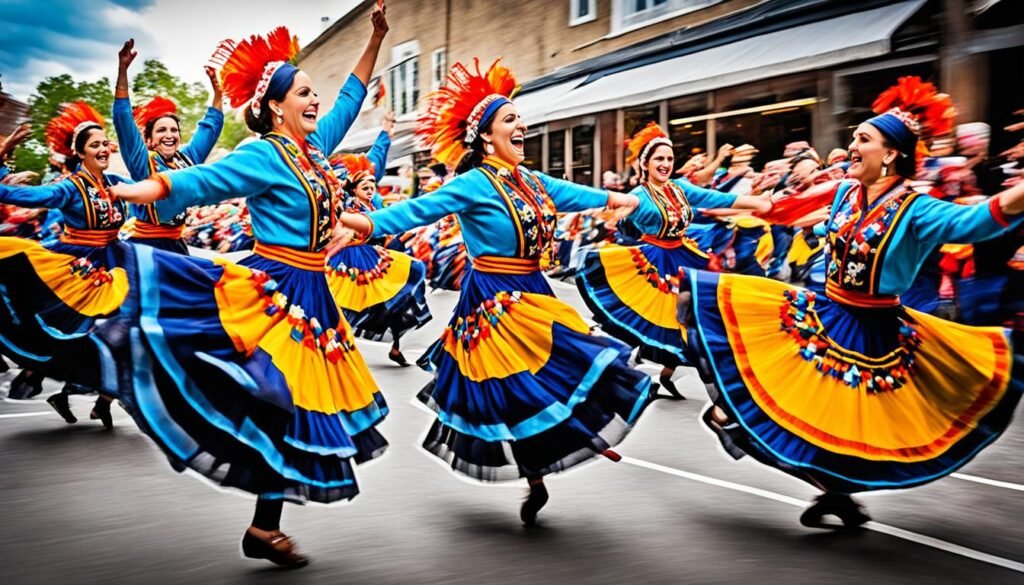Folk Music Cultures : The heartbeat of folk music is its rhythm. It drives the traditions forward, rich with cultural expression. From West African beats to Balinese ensembles, the rhythmic language tells stories. These stories are of diverse human experiences that have influenced these musical worlds. This article is a journey. It uncovers the heart of folk music, exploring its cultural roots, expressions, and modern blends that mesmerize people worldwide.
Key Takeaways : Folk Music Cultures
- Discover the foundational role of rhythm in shaping the distinctive sonic landscapes of folk music cultures.
- Explore the diverse rhythmic patterns and meters that reflect the cultural narratives and traditions of different regions.
- Understand how rhythm, melody, harmony, and timbre intertwine to create the rich and expressive musical tapestries of folk music.
- Delve into the innovative ways in which folk music is adapting and evolving, blending traditional elements with contemporary influences.
- Gain insights into the cultural significance and functionality of folk music, beyond the mere notes and rhythms.
Rhythmic Foundations: Unraveling the Heartbeat of Music
Rhythm is at the heart of all music. It gives songs their pulse and shape. This “‘heartbeat” makes each culture’s music unique.
Defining Rhythm: The Building Block of Musical Expression
Rhythm is the pattern of sounds and silences in music. It sets the pace by controlling when notes start and stop. This is why it’s so key in songs and dances from all over the world.
Beats, Tempo, and Meter: Navigating the Rhythmic Landscape
The beat is music’s fundamental unit of time. The tempo, or speed, changes how fast or slow a piece feels. Meanwhile, the meter organizes the beats into patterns, showing its structure.
| Rhythmic Element | Definition | Example |
|---|---|---|
| Beat | The basic unit of time in music, the pulse that underpins the rhythm | The steady tapping of a drum or the tick of a metronome |
| Tempo | The speed or pace of the beats, measured in beats per minute (BPM) | A lively folk dance might have a tempo of 120 BPM, while a soulful ballad could be around 80 BPM |
| Meter | The pattern of strong and weak beats that creates a sense of rhythmic organization | A waltz in 3/4 time, with three beats per measure, or a march in 4/4 time, with four beats per measure |
Beats, tempo, and meter are the very basics of music’s language. They provide the structure that makes each cultural music style distinct.
“Rhythm is the life of motion, and it is the heart of culture.”
– Pearl Primus, American dancer and choreographer
Melodic Tapestries: Weaving Tales Through Sound
The melody is a key part of folk music. It tells cultural tales and expresses emotions. Musicians use it to show the identity of their traditions. We’ll look at how pitch, scale, and melodic contour tell musical stories beyond borders.
Pitch, Scale, and Contour: Crafting Melodies with Intention
Pitch is how high or low a sound is. It’s crucial for creating melodies. Musicians pick and organize pitches into a scale. This scale gives melodies their unique tonal center.
The melodic contour shapes the melody. This gives the music its feeling and cultural flair.
Composers in folk music use pitch, scale, and contour to make captivating songs. Understanding these aspects shows how musical storytelling is central to folk music.
“Melody is the soul of music. It is the primary carrier of emotional expression, cultural identity, and musical storytelling.”
Exploring folk melodies, we see how cultural influences form unique songs. These songs help keep cultures alive and changing.
Harmonic Resonance: Intertwining Voices, Intertwining Cultures
Folk music is like a rich tapestry. It brings together many voices in perfect harmony, showing the world’s cultural mix. At its core is harmony, where different melodies blend together beautifully. This creates a powerful link between people, showing we’re all united through music.
Every part of the world has its own way of using harmony in folk music. For example, Central African songs use many voices to create complex sounds. On the other hand, Middle Eastern music uses special scales to build their melodies. These examples show how cultural influences shape folk music’s unique sound.
musical interaction plays a key role in bringing harmony to folk music. When musicians from different cultures join forces, they mix their musical styles. This mix of sounds can be both smooth and sometimes not. But, this combination beautifully shows how we are all connected, beyond borders or beliefs.
“Music is the universal language of mankind.” – Henry Wadsworth Longfellow
Studying the harmony in folk music teaches us the power of music as a universal language. It helps us understand and appreciate different cultures. The sound of a Mongolian song or a South American piece proves it. Their harmonies show how music truly brings people together, no matter where we’re from.
Timbral Tapestry: Exploring the Colors of Folk Music
Folk music is filled with unique sounds. This comes from the special qualities of each sound. These sounds make up the different kinds of folk music we hear. For example, the gentle notes of a wooden flute contrast with the sharpness of a hammered dulcimer.
Instrument Materials and Articulations: Shaping Sonic Identities
Traditional instruments often reflect a community’s culture and environment. The people of the Andes, for one, use the cane plant to make their pan pipes. This not only makes a unique sound but also represents the area’s natural beauty.
The skills of the people who make and play these instruments are just as vital. The way they play – whether they pluck, bow, strike, or blow into an instrument – alters the sound. This adds different feelings and meanings to the music.
For instance, the kora from West Africa is a harp-like instrument. When played, it spreads a beautiful sound, echoing the region’s musical history. In contrast, Australia’s didgeridoo has a deep, vibrating sound thanks to a special way of breathing while playing.
“The materials, construction, and articulation techniques of traditional instruments play a crucial role in shaping the timbral tapestry that captivates audiences worldwide.”
Studying instrument design tells us a lot about different cultures. Combining culture, skill, and performance brings out folk music’s rich diversity. It stands as a proof of the creativity and passion in communities around the world.
Dynamic Dances: Ebbs and Flows of Musical Expression
In folk music, dynamics are crucial. They impact the emotional feel and cultural meaning of the music. Composers and performers change the loudness and softness on purpose. This gives a sense of movement and tells a story. It mirrors the ups and downs we all face and the values of their culture.
Sudden loud or soft changes in folk music can make you feel strong or vulnerable. Gentle volume shifts make you think deeply. These effects grip the listener and show the music’s cultural background.
Folk music ranges from loud dances to soft lullabies. These changes in loudness and softness draw us into the culture. They help us see the history and emotions within the music.
“The dynamics of folk music are the heartbeat that breathes life into the cultural narratives woven through its melodies and rhythms.”
Exploring folk music’s dynamic nature shows its evolution and resilience. It adapts to new cultures while keeping its old roots. The changes in folk music are a sign of its lasting strength and vibrancy.
Let’s dive into the world of folk music. We’ll see the dynamic dances of cultural impact and emotional richness. These dances are a core part of the music’s timeless beauty.
Textural Terrains: Navigating the Intricate Landscapes
The world of folk music is like a rich tapestry, made of many unique sounds. Each tradition has its own way of creating music. This includes everything from simple melodies to complex harmonies. Through their music, different cultures share their stories and values.
Monophony, Heterophony, and Homophony: Voices in Harmony
Music texture is about how different voices in a song relate to each other. In folk music, these voices can sound as one, flow separately, or harmonize perfectly together. This shows the traditions and ways communities work together in their music.
Monophonic songs have a single, powerful melody. They are great for telling stories and bringing people together. The focus on the melody highlights the culture’s musical soul.
Heterophony is when different voices add their own flair to the same melody. It demonstrates both togetherness and individuality. Each voice plays a unique part in a larger, beautiful song.
Homophonic music uses parallel melodies for a strong, unified sound. This style symbolizes coming together. It shows the power of community in music.
| Textural Approach | Cultural Reflection | Musical Characteristics |
|---|---|---|
| Monophony | Storytelling, Communal Bonding | Single Melodic Line |
| Heterophony | Unity and Individuality | Multiple Voices Elaborating on Shared Melody |
| Homophony | Cultural Unity, Shared Identity | Parallel Movement of Multiple Voices |
Exploring different musical textures helps us understand folk music’s depth. We see the strong cultural meanings, aesthetics, and community in each tradition. This brings the world’s folk music closer to us.
Structural Symphonies: Mapping the Musical Journey
The shape of a musical piece is key in showing off folk music’s culture. Composers and performers pick special forms and structures to make a story and a musical trip. These choices show the cultural tales and human feelings these songs want to tell.
The core of a musical trip is the musical form. It’s the plan that controls the music’s movement. From simple folk songs to complex ballads, the form helps share cultural ideas and stories. Each song is a story that evolves, taking the listener through a musical journey.
The way folk music is structured often reflects its deep cultural roots. This includes rhythms, melodies, and harmonies from the community’s traditions. These cultural influences blend into the music’s form, making a unique sound that speaks to everyone’s shared experiences.
| Musical Form | Cultural Influence | Storytelling Narrative |
|---|---|---|
| Ballad | Oral traditions, poetic forms | Epic tales of heroism, love, and tragedy |
| Call-and-response | Call-and-response patterns in community gatherings | Communal dialogue and shared experience |
| Rondo | Cyclical nature of seasonal celebrations and rituals | Recurrent themes and motifs representing the cycles of life |
By looking at these structural choices, we learn more about the folk music’s cultural stories. Every form, rhythm, and melody is a part of the big picture. They capture what it means to be human in a specific culture.
“Music is the social glue that binds communities together, and its structural forms are the conduits through which cultural stories are passed down and shared.”
Uncovering the structural symphonies of folk music shows a rich mix of cultures and stories. This journey teaches us how music can bridge gaps, connecting people over time and space with its universal melodies and rhythms.
Folk Music Cultures: Echoes of Tradition, Whispers of Innovation
The beauty of folk music lies in its mix of old traditions and new ideas. Created over centuries, this music reflects our shared heritage. It changes with time, keeping its deep cultural roots alive.
Folk music’s impact on the world’s music scene is huge. Its rhythms and melodies tell stories of our past together. When we explore this music, we see how well it blends old traditions with new creativity.
Folk music thrives by mixing the old with the new. Instruments like guitars, fiddles, and drums are used in fresh ways. This fusion of past and present creates music that both respects history and innovates.
- Combining folk sounds with electronic music creates a new style: ethno-electro. This music blends ancient rhythms with modern beats in a mesmerizing way.
- Artists often draw from folk music’s deep cultural well for inspiration. They add their unique stories to the worldwide music scene.
- When traditional and new musicians work together, they create exciting new music genres. These innovations grab attention around the globe.
As folk music changes and grows, it connects us all. It breaks down barriers and highlights our shared human experiences. This music is both ancient and new, inviting us to join its ongoing story.
“Music is the universal language of mankind.” – Henry Wadsworth Longfellow
Sonic Storytelling: Unveiling Cultural Narratives
In folk music cultures, music tells stories of people’s lives and shares their wisdom. It goes beyond just sounds, diving into the heart of their experiences. The music helps us explore and understand what it means to be human in rich, diverse ways.
Folk music is more than something to listen to—it speaks volumes of cultural history, faith, and deep feelings. It acts as a common ground, linking us all by shared emotions through sounds.
Musical Meaning and Functionality: Beyond Notes and Rhythms
The heart of folk music isn’t just in its technical parts like rhythm and melody. Its true magic lies in telling stories and sharing beliefs. It’s a way to express life’s deeper layers, rich with history and meanings.
- Folk music as a medium for cultural preservation and transmission
- Symbolic and spiritual meanings embedded in musical structures
- The role of folk music in community bonding and identity formation
- Therapeutic and cathartic qualities of folk music traditions
Exploring folk music’s essence reveals a world of human stories. Its beats and tunes link us to the soul of different cultures. It’s an invitation to discover the languages that speak to us all.
“Music has the power to transcend boundaries, to connect people from different backgrounds, and to reveal the shared experiences that unite us as human beings.”
Ethno-Electro: Exploring Cultural Influences in Electroacoustic Realms
Music keeps changing, and now, electroacoustic music meets traditional folk. They mix to create “ethno-electro.” This mix shows how composers and musicians bring cultural influences into the electronic and fusion world.
New technologies help save and change cultural sounds in the digital realm. Musicians mix tradition like instruments, rhythms, and melodies with electronic methods. This mix makes a beautiful sound that highlights the world’s music diversity.
Ethno-electro blends field recordings, analog synthesis, and digital tech. This mix saves the spirit of cultural roots and makes it new. It supports a fresh way of creativity, mixing old traditions with new ideas.
“Ethno-electro is a powerful medium for cultural preservation and artistic expression, where the past and the future converge, creating a sonic bridge that transcends geographical and temporal divides.”
Ethno-electro is growing, becoming a place for unique stories. Musicians use both old and new sounds to tell these tales. Mixing traditional musical elements with the latest tech offers endless creative opportunities.
Ethno-electro shows us how combining cultural music with technology is powerful. It attracts people and leads to new ways of creating art. This music introduces us to a world of sound that brings people together beyond borders.
Also Read : Rhythm And Blues : Exploring The Heartbeat Of America
Conclusion: Embracing the Rhythmic Reverberations
We find ourselves immersed in the many colors of folk music. It shows us how rhythm can go beyond borders, keep culture alive, and create new art. The beat in these songs is like a bridge to endless exploration in music.
Folk music around the world proves how creative and adaptable people are. The way melodies and harmonies blend tells stories of lands we’ve never seen. When we follow the beat of these traditions, we celebrate history and open doors to fresh creativity.
Our journey in folk music is ending, but let’s remember its importance. It keeps our cultures alive, helps us understand others, and inspires the future. The rhythmic echoes show us that human creativity is boundless. Music, as a universal language, brings us together to enjoy our diverse world.
FAQs
What are the foundational elements that shape the distinctive sonic landscapes of folk music cultures?
Folk music’s unique sound comes from many elements. These include rhythm, melody, harmony, and more. Together, they create stories and music that last through time.
How does rhythm serve as the foundation of music and what are its key components?
Rhythm is crucial in music, giving it structure and life. It includes beats, tempo, and meter. These elements build the song’s heartbeat.
What is the role of melody in folk music cultures?
Melody arranges sounds in a song. It carries stories and feelings. Through pitch and rhythm, it reflects the culture it comes from.
How does harmony shape the sonic identity of folk music cultures?
Harmony blends different sounds together. It’s key in defining a culture’s music. Beyond melody, it speaks to cultural values and style.
What is the significance of timbre in the exploration of folk music cultures?
Timbre brings unique sound qualities to music. It’s key in exploring folk genres. Traditional instruments’ tones help capture culture through sound.
How do dynamics shape the emotional resonance and cultural identity of folk music?
Dynamics change how music feels and sounds. In folk music, they’re vital. They mirror life’s ups and downs and cultural stories.
What is the significance of texture in folk music cultures?
Texture is about the layers and sounds in music. It varies from simple to complex. This reflects the culture and values behind the music.
How does the structure of a musical piece play a role in the cultural expression of folk music?
Musical structure tells a story and shares culture. It shapes the journey of a song. This carries the community’s history and experiences.
How have folk music cultures evolved and adapted over time?
Over time, folk music has changed and grown. It keeps its old stories while embracing new sounds. This makes its world rich and varied.
What is the deeper meaning and functionality of folk music cultures?
Folk music is a rich cultural language. It shares stories, beliefs, and feelings. It connects people and expresses the human experience.
What is the intersection of folk music cultures and electroacoustic techniques, and how has it given rise to the “ethno-electro” genre?
The mix of folk and electroacoustic sounds has birthed “ethno-electro.” It blends tradition with new digital sounds. This fusion keeps cultural roots alive in modern music.
Source Links
- https://kaitlinbove.com/elements-of-music
- https://music.biz.id/melodic-journeys-tales-of-musical-exploration/
- http://www.ems-network.org/IMG/pdf_EMS12_rothbart.pdf








